Abstract
Elastase is released from human neutrophils during the early events of blood coagulation. Human plasma kallikrein has been shown to stimulate neutrophil chemotaxis, aggregation, and oxygen consumption. Therefore, the ability of kallikrein to release neutrophil elastase was investigated. Neutrophils were isolated by dextran sedimentation, and elastase release was measured by both an enzyme-linked immunosorbent assay, and an enzymatic assay using t-butoxy-carbonyl-Ala-Ala-Pro-Val-amino methyl coumarin as the substrate. Kallikrein, 0.1-1.0 U/ml, (0.045-0.45 microM), was incubated with neutrophils that were preincubated with cytochalasin B (5 micrograms/ml). The release of elastase was found to be proportional to the kallikrein concentration. Kallikrein released a maximum of 34% of the total elastase content, as measured by solubilizing the neutrophils in the nonionic detergent Triton X-100. A series of experiments was carried out to determine if kallikrein was a major enzyme involved in neutrophil elastase release during blood coagulation. When 10 million neutrophils were incubated in 1 ml of normal plasma in the presence of 30 mM CaCl2 for 90 min, 2.75 micrograms of elastase was released. In contrast, neutrophils incubated in prekallikrein-deficient or Factor XII-deficient plasma released less than half of the elastase, as compared with normal plasma. The addition of purified prekallikrein to prekallikrein-deficient plasma restored neutrophil elastase release to normal levels. Moreover, release of elastase was enhanced in plasma deficient in C1-inhibitor, the major plasma inhibitor of kallikrein. This release was not dependent upon further steps in the coagulation pathway, or on C5a, since levels of elastase, released in Factor XI- or C5-deficient plasma, were similar to that in normal plasma, and an antibody to C5 failed to inhibit elastase release. These data suggest that kallikrein may be a major enzyme responsible for the release of elastase during blood coagulation.
Full text
PDF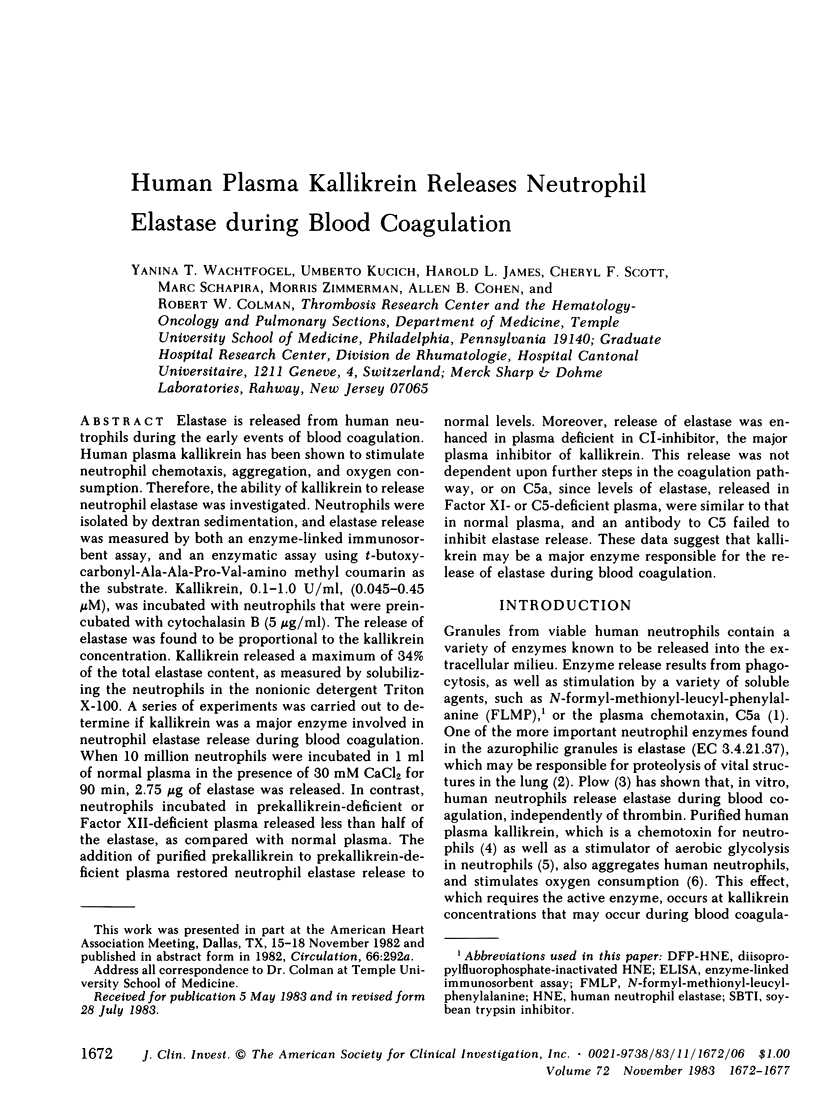
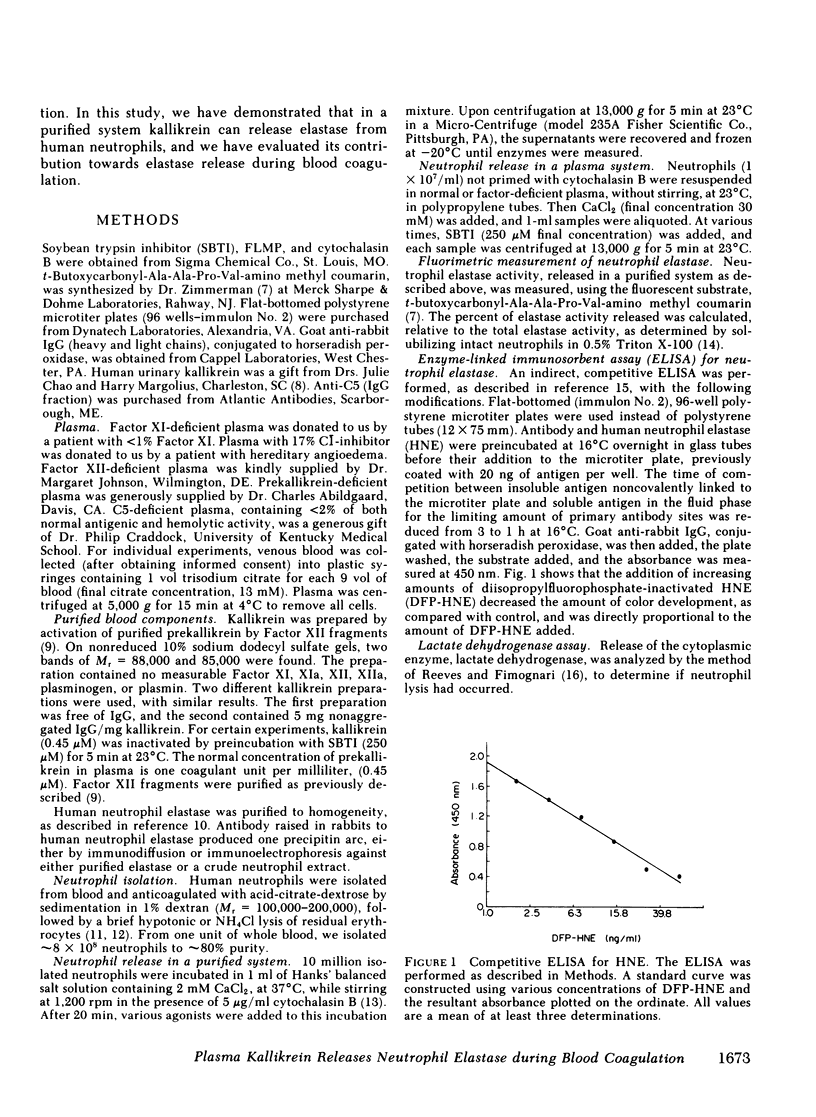
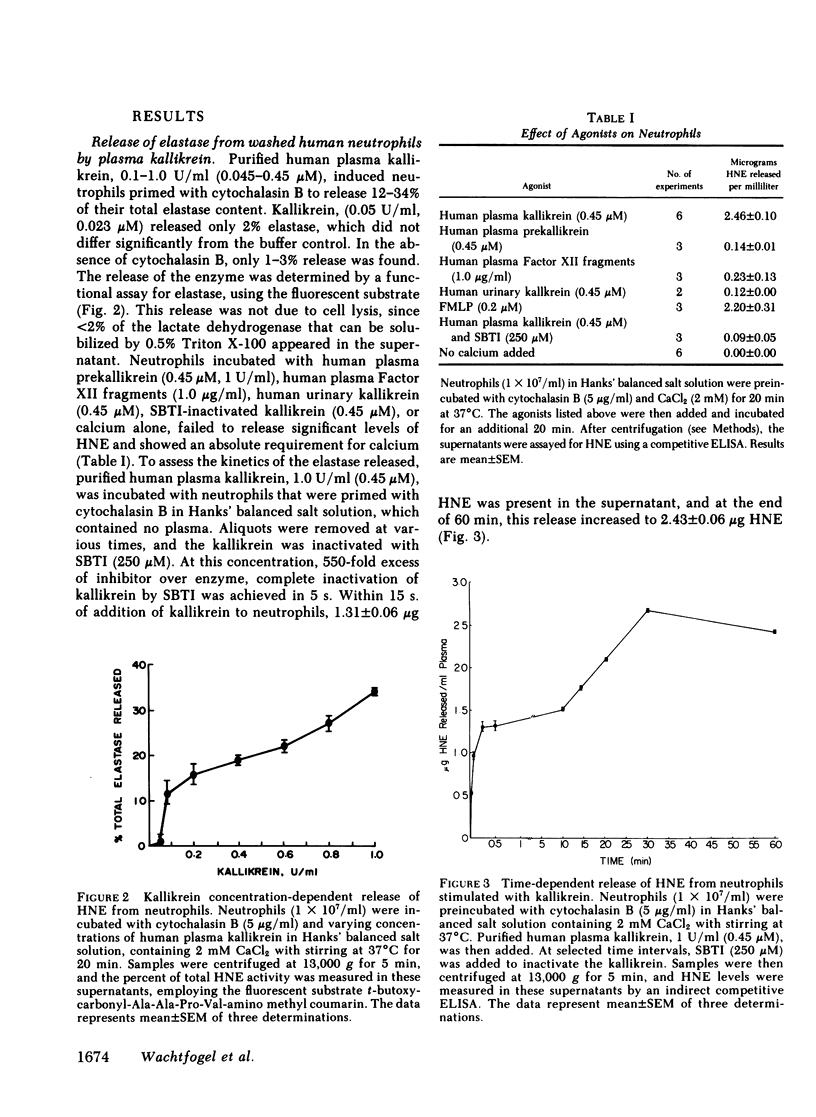
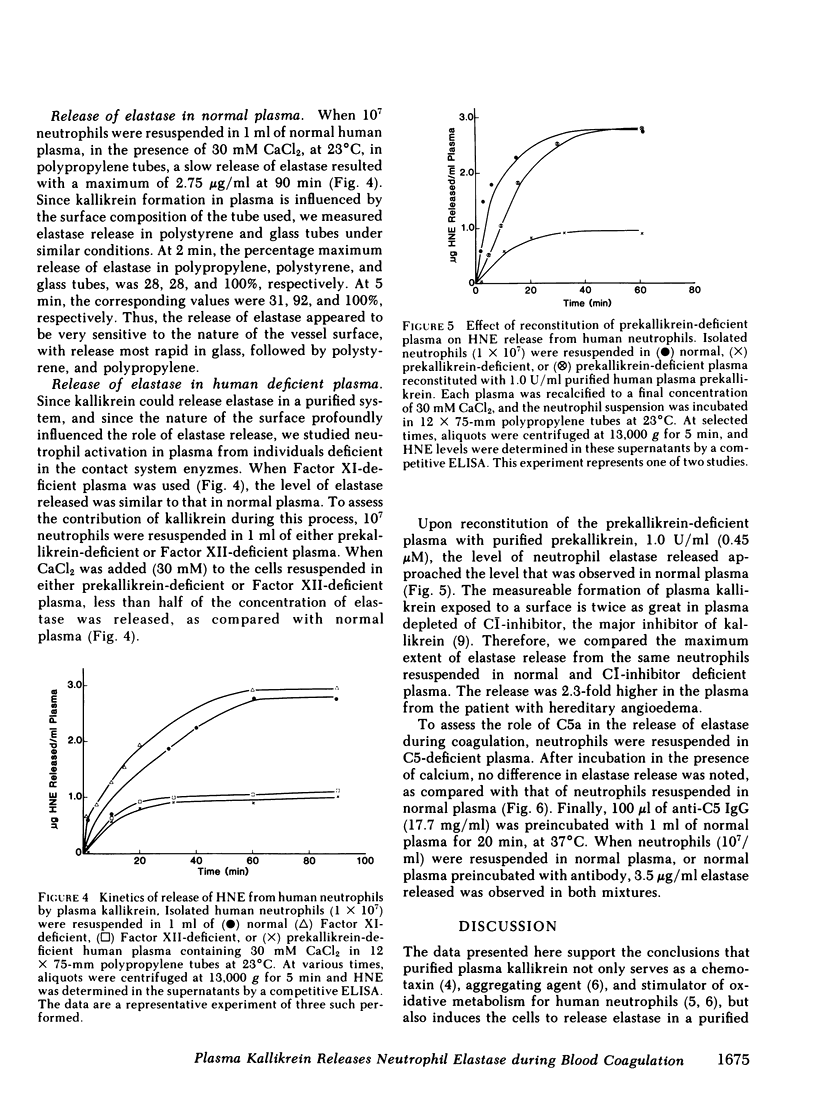
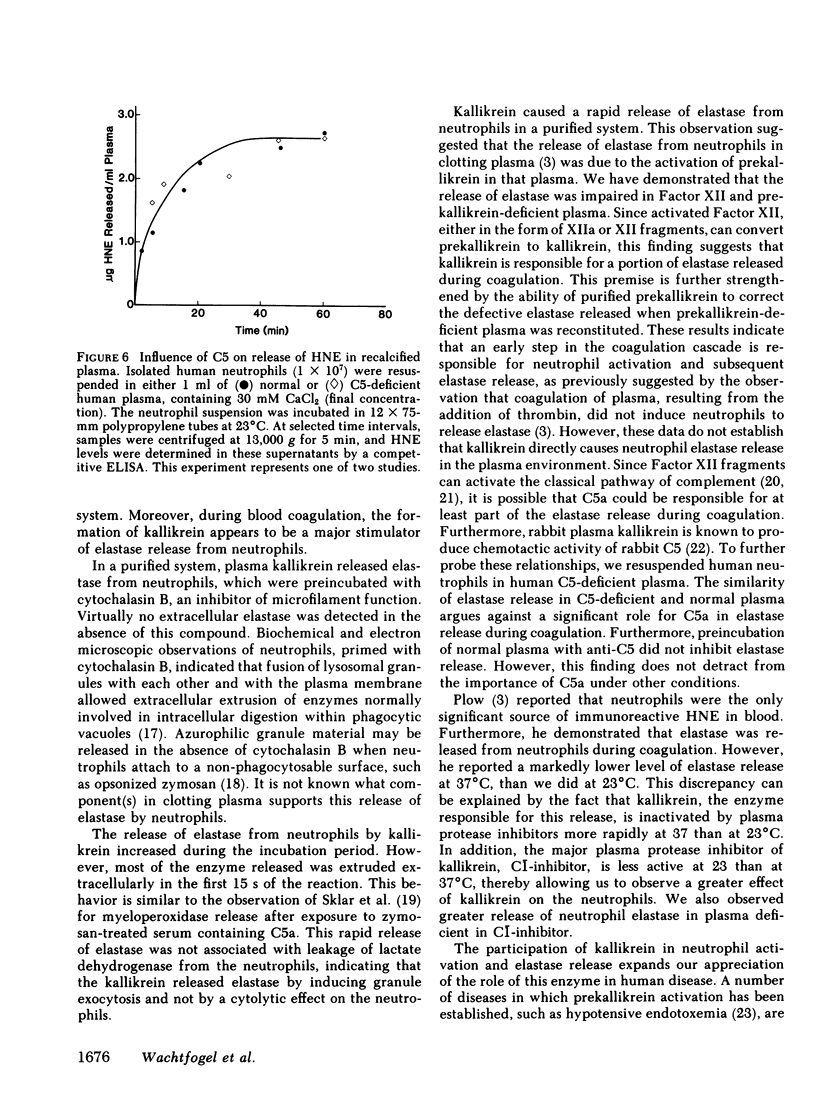

Selected References
These references are in PubMed. This may not be the complete list of references from this article.
- AGOSTONI A., IDEO G. SEPARATION OF LARGE NUMBERS OF LYMPHOCYTES FROM HUMAN BLOOD. Experientia. 1965 Feb 15;21:82–83. doi: 10.1007/BF02144754. [DOI] [PubMed] [Google Scholar]
- Baugh R. J., Travis J. Human leukocyte granule elastase: rapid isolation and characterization. Biochemistry. 1976 Feb 24;15(4):836–841. doi: 10.1021/bi00649a017. [DOI] [PubMed] [Google Scholar]
- Bentwood B. J., Henson P. M. The sequential release of granule constitutents from human neutrophils. J Immunol. 1980 Feb;124(2):855–862. [PubMed] [Google Scholar]
- Böyum A. Isolation of mononuclear cells and granulocytes from human blood. Isolation of monuclear cells by one centrifugation, and of granulocytes by combining centrifugation and sedimentation at 1 g. Scand J Clin Lab Invest Suppl. 1968;97:77–89. [PubMed] [Google Scholar]
- Castillo M. J., Nakajima K., Zimmerman M., Powers J. C. Sensitive substrates for human leukocyte and porcine pancreatic elastase: a study of the merits of various chromophoric and fluorogenic leaving groups in assays for serine proteases. Anal Biochem. 1979 Oct 15;99(1):53–64. doi: 10.1016/0003-2697(79)90043-5. [DOI] [PubMed] [Google Scholar]
- Donaldson V. H. Mechanisms of activation of C'1 esterase in hereditary angioneurotic edema plasma in vitro. J Exp Med. 1968 Mar 1;127(3):411–429. doi: 10.1084/jem.127.3.411. [DOI] [PMC free article] [PubMed] [Google Scholar]
- Fisher C. A., Schmaier A. H., Addonizio V. P., Colman R. W. Assay of prekallikrein in human plasma: comparison of amidolytic, esterolytic, coagulation, and immunochemical assays. Blood. 1982 May;59(5):963–970. [PubMed] [Google Scholar]
- Ghebrehiwet B., Silverberg M., Kaplan A. P. Activation of the classical pathway of complement by Hageman factor fragment. J Exp Med. 1981 Mar 1;153(3):665–676. doi: 10.1084/jem.153.3.665. [DOI] [PMC free article] [PubMed] [Google Scholar]
- Goetzl E. J., Austen K. F. Stimulation of human neutrophil leukocyte aerobic glucose metabolism by purified chemotactic factors. J Clin Invest. 1974 Feb;53(2):591–599. doi: 10.1172/JCI107594. [DOI] [PMC free article] [PubMed] [Google Scholar]
- Goldstein I., Hoffstein S., Gallin J., Weissmann G. Mechanisms of lysosomal enzyme release from human leukocytes: microtubule assembly and membrane fusion induced by a component of complement. Proc Natl Acad Sci U S A. 1973 Oct;70(10):2916–2920. doi: 10.1073/pnas.70.10.2916. [DOI] [PMC free article] [PubMed] [Google Scholar]
- Janoff A., Sloan B., Weinbaum G., Damiano V., Sandhaus R. A., Elias J., Kimbel P. Experimental emphysema induced with purified human neutrophil elastase: tissue localization of the instilled protease. Am Rev Respir Dis. 1977 Mar;115(3):461–478. doi: 10.1164/arrd.1977.115.3.461. [DOI] [PubMed] [Google Scholar]
- Kaplan A. P., Kay A. B., Austen K. F. A prealbumin activator of prekallikrein. 3. Appearance of chemotactic activity for human neutrophils by the conversion of human prekallikrein to kallikrein. J Exp Med. 1972 Jan;135(1):81–97. doi: 10.1084/jem.135.1.81. [DOI] [PMC free article] [PubMed] [Google Scholar]
- Kucich U., Abrams W. R., James H. L. Solid-phase immunoassay of dog neutrophil elastase. Anal Biochem. 1980 Dec;109(2):403–409. doi: 10.1016/0003-2697(80)90668-5. [DOI] [PubMed] [Google Scholar]
- Mason J. W., Kleeberg U., Dolan P., Colman R. W. Plasma kallikrein and Hageman factor in Gram-negative bacteremia. Ann Intern Med. 1970 Oct;73(4):545–551. doi: 10.7326/0003-4819-73-4-545. [DOI] [PubMed] [Google Scholar]
- Plow E. F. Leukocyte elastase release during blood coagulation. A potential mechanism for activation of the alternative fibrinolytic pathway. J Clin Invest. 1982 Mar;69(3):564–572. doi: 10.1172/JCI110482. [DOI] [PMC free article] [PubMed] [Google Scholar]
- REEVES W. J., Jr, FIMOGNARI G. M. AN IMPROVED PROCEDURE FOR THE PREPARATION OF CRYSTALLINE LACTIC DEHYDROGENASE FROM HOG HEART. J Biol Chem. 1963 Dec;238:3853–3858. [PubMed] [Google Scholar]
- Schapira M., Despland E., Scott C. F., Boxer L. A., Colman R. W. Purified human plasma kallikrein aggregates human blood neutrophils. J Clin Invest. 1982 May;69(5):1199–1202. doi: 10.1172/JCI110557. [DOI] [PMC free article] [PubMed] [Google Scholar]
- Shimamoto K., Chao J., Margolius H. S. The radioimmunoassay of human urinary kallikrein and comparisons with kallikrein activity measurements. J Clin Endocrinol Metab. 1980 Oct;51(4):840–848. doi: 10.1210/jcem-51-4-840. [DOI] [PubMed] [Google Scholar]
- Sklar L. A., McNeil V. M., Jesaitis A. J., Painter R. G., Cochrane C. G. A continuous, spectroscopic analysis of the kinetics of elastase secretion by neutrophils. The dependence of secretion upon receptor occupancy. J Biol Chem. 1982 May 25;257(10):5471–5475. [PubMed] [Google Scholar]
- Wiggins R. C., Giclas P. C., Henson P. M. Chemotactic activity generated from the fifth component of complement by plasma kallikrein of the rabbit. J Exp Med. 1981 Jun 1;153(6):1391–1404. doi: 10.1084/jem.153.6.1391. [DOI] [PMC free article] [PubMed] [Google Scholar]
- Yamada H., Damiano V. V., Tsang A. L., Meranze D. R., Glasgow J., Abrams W. R., Weinbaum G. Neurtrophil degranulation in cadmium-chloride-induced acute lung inflammation. Am J Pathol. 1982 Nov;109(2):145–156. [PMC free article] [PubMed] [Google Scholar]
- Zurier R. B., Hoffstein S., Weissmann G. Cytochalasin B: effect on lysosomal enzyme release from human leukocytes. Proc Natl Acad Sci U S A. 1973 Mar;70(3):844–848. doi: 10.1073/pnas.70.3.844. [DOI] [PMC free article] [PubMed] [Google Scholar]


